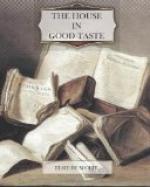Perhaps you will have a guest-room, but I doubt it. Most women find it more satisfactory and less expensive to send their guests to a nearby hotel than to keep an extra room for a guest. The guest room is impractical in a small apartment, but you can arrange to take care of an over-night guest by planning your living-room wisely.
As for the kitchen—that is another story. It is impossible to go into that subject. And anyway, you will find the essentials supplied for you by the landlord. You won’t need my advice when you need a broom or a coffee pot or a saucepan—you’ll go buy it!
XVII
REPRODUCTIONS OF ANTIQUE FURNITURE AND OBJECTS OF ART
One must have preserved many naive illusions if one may believe in all the “antiques” that are offered in the marketplaces of the world to-day. Even the greatest connoisseurs are caught napping sometimes, as in the case of the famous crown supposedly dating to the Fifth Century, B.C., which was for a brief period one of the treasures of the Louvre. Its origin was finally discovered, and great was the outcry! It had been traced to a Viennese artisan, a worker in the arts and crafts.
[Illustration: MRS. C.W. HARKNESS’S CABINET FOR OBJETS D’ART]
Surely, if the great men of the Louvre could be so deceived it is obvious that the amateur collector has little chance at the hands of the dealers in old furniture and other objects of art. Fortunately, the greatest dealers are quite honest. They tell you frankly if the old chair you covet is really old, if it has been partially restored, or if it is a copy, and they charge you accordingly. At these dealers a small table of the Louis XVI period, or a single chair covered in the original tapestry, may cost as much as a man in modest circumstances would spend on his whole house. Almost everything outside these princely shops (salons is a better word) is false, or atrociously restored. Please remember I am not referring to reputable dealers, but to the smaller fry, whose name is legion, in whose shops the unwary seeker after bargains is sure to be taken in.
Italy is, I think, the greatest workshop of fraudulent reproductions. It has an output that all Europe and America can never exhaust. Little children on the streets of Naples still find simpletons of ardent faith who will buy scraps of old plaster and bits of paving stones that are alleged to have been excavated in Pompeii.
In writing about antiques it is not easy to be consistent, and any general conclusion is impossible. Certain reproductions are objectionable, and yet they are certainly better than poor originals, after all. The simplest advice is the best and easiest to follow: The less a copy suggests an attempt at “artistic reproduction,” the more literal and mechanical it is in its copy of the original, the better it is. A good photograph of a fine old painting is superior to the average copy in oils or watercolors. A chair honestly copied from a worm eaten original is better for domestic purpose than the original. The original, the moment its usefulness is past, belongs in a museum. A plaster cast of a great bust is better than the same object copied in marble or bronze by an average sculptor. And so it goes. Think it out for yourself.




